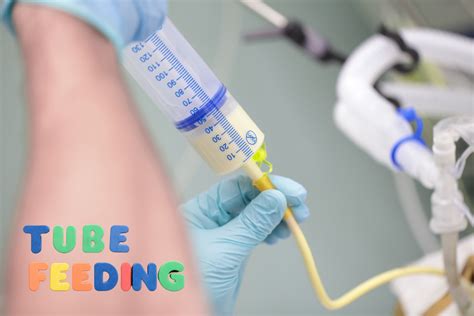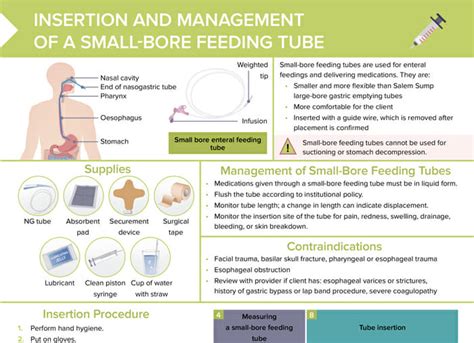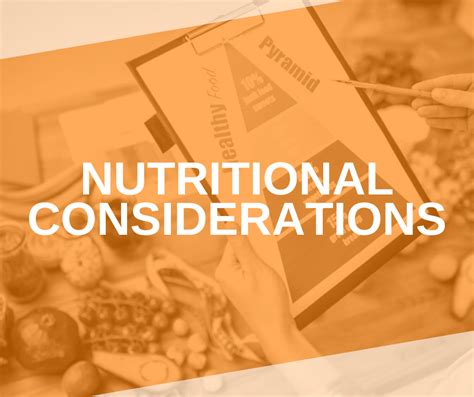Intro
Discover 5 essential tips for feeding tube management, including tube placement, nutrition planning, and complication prevention, to ensure safe and effective enteral nutrition for patients with feeding tubes.
Feeding tubes have become a vital part of medical care for individuals who have difficulty consuming food orally due to various health conditions. The use of feeding tubes can ensure that these individuals receive the necessary nutrients for their bodies to function properly. However, managing a feeding tube requires careful attention to detail and adherence to specific guidelines to prevent complications and ensure the tube functions as intended. Here are some key considerations and tips for individuals with feeding tubes and their caregivers.
The importance of proper feeding tube management cannot be overstated. It not only helps in maintaining the health and well-being of the individual but also prevents potential complications such as infection, clogging of the tube, and discomfort. Understanding the different types of feeding tubes, their placement, and the nutritional requirements of the individual is crucial. Moreover, recognizing the signs of potential issues and knowing how to address them promptly can make a significant difference in the quality of care provided.
For those who are new to managing a feeding tube, the process can seem daunting. However, with the right guidance and support, it becomes more manageable. The goal is to ensure that the individual receives the nutrients they need while minimizing the risk of complications. This involves a combination of understanding the feeding schedule, preparing the formula correctly, administering the feeding, and monitoring the individual's response. Additionally, maintaining the cleanliness of the tube and the surrounding area is vital to prevent infections.
Understanding Feeding Tubes

Types of Feeding Tubes
The choice of feeding tube depends on the individual's medical condition, the anticipated duration of use, and personal preferences. Nasogastric tubes are inserted through the nose and into the stomach, making them suitable for short-term use. Gastrostomy tubes are placed directly into the stomach through an opening in the abdominal wall and are often used for longer-term feeding. Jejunostomy tubes are inserted into the small intestine and are typically used for individuals who have difficulty absorbing nutrients in the stomach.Managing Feeding Tube Care

Preventing Complications
Preventing complications is a key aspect of feeding tube management. This can be achieved by following the healthcare provider's instructions carefully, monitoring for signs of infection or other issues, and seeking medical attention promptly if any problems arise. Regular follow-up appointments with healthcare providers are also essential to assess the individual's nutritional status and adjust the feeding regimen as necessary.Nutritional Considerations

Administering Feedings
Administering feedings through a feeding tube requires careful attention to detail. This includes preparing the formula according to the manufacturer's instructions, using the correct administration set, and delivering the feeding at the prescribed rate. It's also important to monitor the individual for any signs of discomfort or distress during the feeding process.Emotional and Psychological Support

Coping Mechanisms
Developing coping mechanisms can help individuals and their families adjust to life with a feeding tube. This might include finding ways to make meal times more enjoyable, such as watching favorite TV shows or listening to music, or engaging in activities that do not involve eating, like going for walks or practicing hobbies.Conclusion and Next Steps

Final Thoughts
As we move forward, it's crucial to continue educating ourselves and others about feeding tube management. Sharing experiences, seeking support from healthcare professionals and support groups, and advocating for the needs of individuals with feeding tubes can make a significant difference in their care and well-being.What are the different types of feeding tubes?
+There are several types of feeding tubes, including nasogastric tubes, gastrostomy tubes, and jejunostomy tubes, each with its own specific use and placement within the body.
How do I prevent complications with my feeding tube?
+Preventing complications involves following the healthcare provider's instructions carefully, monitoring for signs of infection or other issues, and seeking medical attention promptly if any problems arise.
What nutritional considerations should I keep in mind for my feeding tube?
+The nutritional needs of individuals with feeding tubes can vary significantly. Working with a healthcare provider or a dietitian to develop a personalized nutrition plan is essential to ensure the individual receives the necessary nutrients.
We invite you to share your thoughts and experiences with feeding tube management in the comments below. Your insights can help others navigate their own journey with feeding tubes. If you found this information helpful, please consider sharing it with others who might benefit from it. Together, we can support individuals with feeding tubes and their families, ensuring they receive the best possible care and support.
